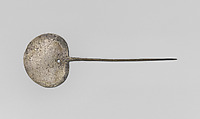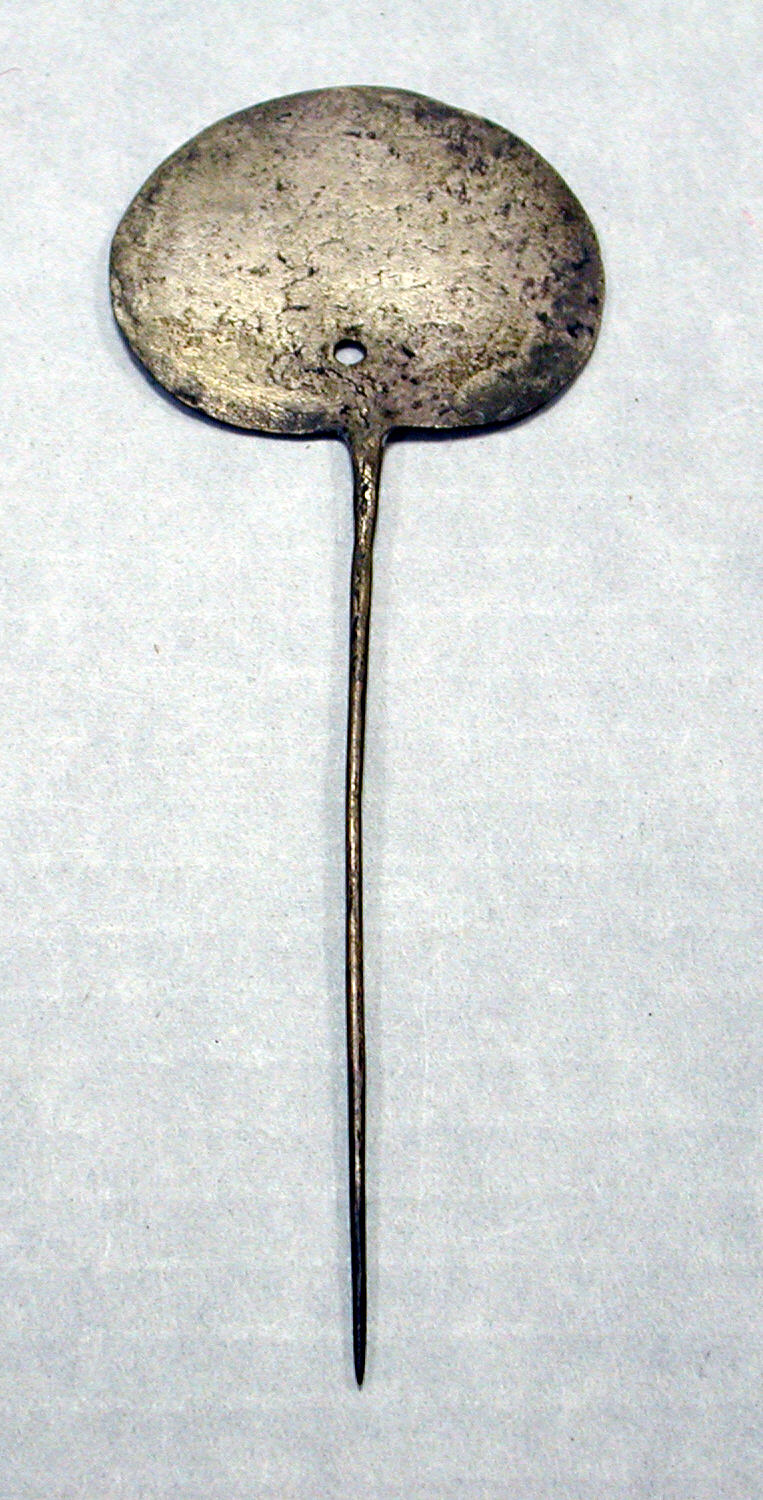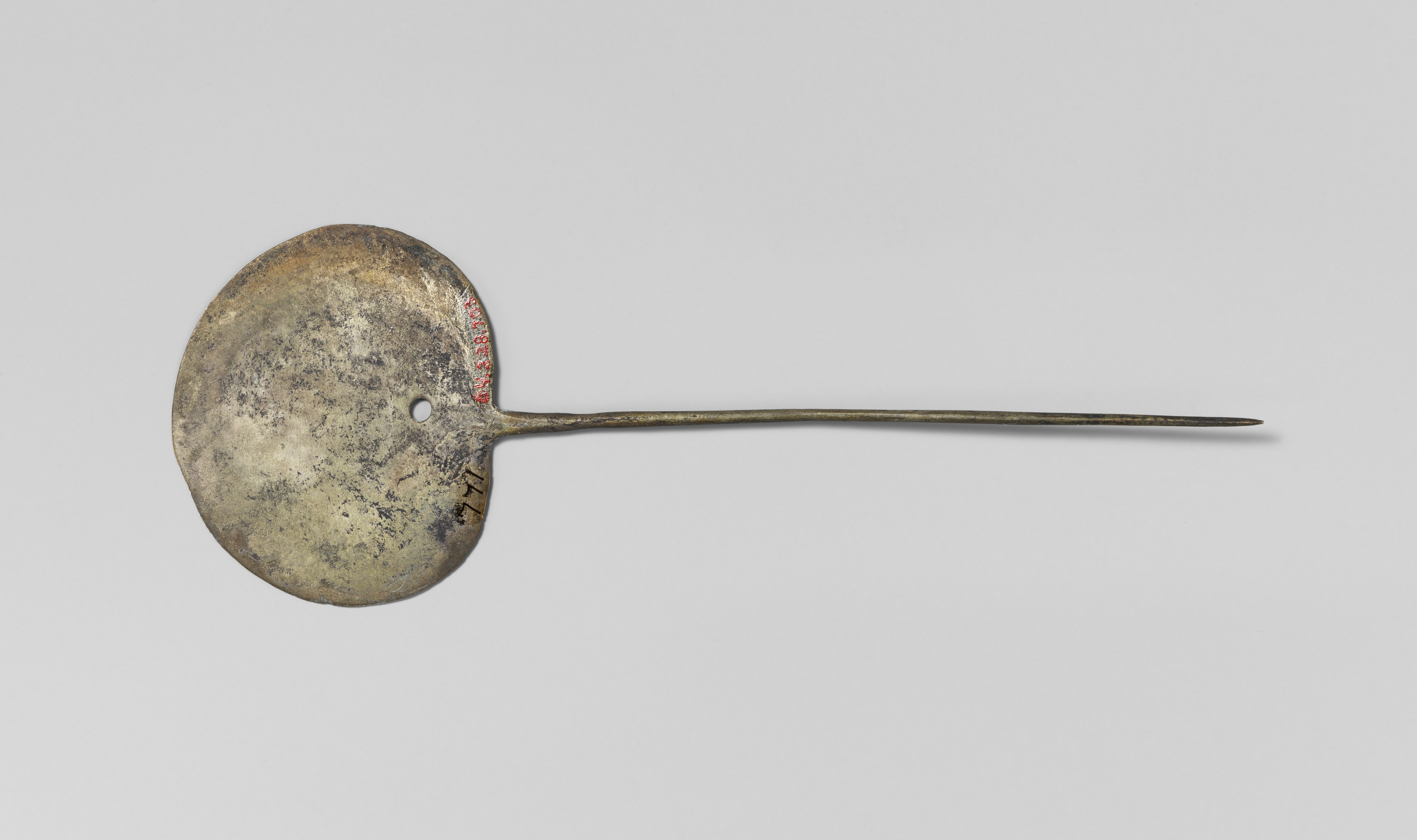Tupu (pin)
Not on view
This object is a tupu, a Quechua term for pin ("pithu" in Aymara and "alfiler" in Spanish), and it is made of silver. Women in the Andes have used these pins to fasten textile garments. The basic tupu form consists of a head and a stem. This particular example is nearly identical in size, shape, and fabrication technique to Metropolitan Museum of Art 64.228.702. While there is no documentation available to suggest that they were from the same archaeological context, it is possible that one person may have worn them as a pair. Typically, women wear two tupus, their heads pointed downward, in order to fasten the acsu or anacu (sometimes referred to in Spanish as saya). This garment is a rectangular textile made of camelid wool that wraps around the body. The tupus may be worn threaded along a cord that passes through their perforations. Indeed, the head of this tupu is undecorated except for a single perforation along its central lengthwise axis. The tupu’s head is thinner than the stem, and its stem is circular in cross-section and ends in a point.
The object is made from one piece of metal. Metalworkers created this tupu by hammering silver.[1] They hammered the part of the rod beyond the stem in order to form the head, and likely alternated hammering with annealing (please see note [2] for a definition). Finally, they punched the metal to form the perforation on the head.[3]
Before being acquired by investor Nathan Cummings, this tupu was in the collection of businessperson Bruno Wassermann who lived in Argentina. He amassed a set of objects, especially Peruvian ceramics, through a combination of excavations in which he participated and separate sales of objects. Wassermann’s collection grew substantially between 1920 and 1948 (Sawyer 1954, 1, 4). The focus of his collection was Peru, but even this wide provenance cannot be assumed for this tupu.
Indeed, this form of tupu, with a round head, is one of the most prevalent forms known in the Andes, geographically and temporally. This form has the greatest frequency (Type 1001) of the forms of tupus that Owen (2012) identifies. Of a sample of 846, there are 243 of this form with a distribution that extends from highland Ecuador to north central Chile. Thus, the present tupu only can be assigned to the wide geographic region related to these comparative tupus, which includes Ecuador, Peru, Bolivia, Argentina, and Chile. The earliest known examples of tupus are from the cemetery at Tablada de Lurín, dating to the end of the Early Horizon and the beginning of the Early Intermediate Period (ca. 300 B.C.–A.D. 300) on the Central Coast of Peru (Cárdenas 1999, 173; Castro de la Mata 2007). The published examples of the Lurín tupus show their forms are different than that of the present tupu. The start of their contextual dates, 300 B.C., can be taken as a beginning date for the production of the present example. This reflects the reality that the chronology of this particular form is unknown and that tupus of very distinct forms were in use at the same time (see, for example, Gibaja et al. 2014). It is clear, however, that there are parallels in form to the present tupu from the Early Intermediate Period, Middle Horizon, Late Intermediate Period, and Late Horizon. The present tupu is technologically distinct from tupus that began to be made at the start of Spanish colonization (please see, for example, Metropolitan Museum of Art 1982.420.10), in spite of some basic similarities in form, hence the ending date assigned for the present tupu.
As this tupu form is documented over an extensive time period in the Andes, it is an important form for understanding histories of Andean metalworking. (For more discussion of the historical uses of tupus in the Andes, please see Metropolitan Museum of Art 64.228.702.) A brief survey of tupus similar to the present example and their technologies is helpful for showing the breadth of the technological traditions of which this tupu is a part. Across the early tupu-making practices in the Andes, people formed the object as one piece. Variation arose in the composition of the metal employed, the primary techniques that gave the tupu its shape, and the application of decoration on the head of the tupu.
Tupus are common features of archaeological assemblages from Wari sites in the central Andes and from sites in the southern Titicaca Basin. People may have fabricated the copper-based metals from these two regions in different ways. In the former case, metalworkers prepared objects from stock metal in the form of sheet. In the latter, they fabricated objects from stock metal in the form of cast rods (Lechtman 2014, 391). Nevertheless, investigators (e.g. Velarde et al. 2012 for the site of La Real, and Velarde et al. 2015 for Tenahaha) have suggested that Wari tupus may have been hammered to shape from cast blanks. It is, indeed, possible that the rod that was subsequently hammered to form the present tupu was originally cast and then drawn to reduce the diameter of its stem. If this is the case, it is likely that the metal is a silver alloy, as silver alone would not be conducive to casting.
The overwhelming majority of tupus and other metal objects from Wari sites like Pikillacta and Conchapata are alloys of copper and arsenic (Lechtman 2014, 381). These sites date to ca. A.D. 600 to A.D. 1000. Their assemblages are part of a copper-arsenic tradition that Lechtman proposes is distinct from that seen at southern Titicaca Basin sites like Tiwanaku and Lukurmata. In these cases, objects, including tupus, tend to be made from alloys of copper, arsenic, and nickel, and others from copper-tin and copper-arsenic. People at these sites were working with the three alloys by A.D. 600 (Lechtman 2014, 391). The distinction in the composition of tupus and other metals between Wari and southern Titicaca Basin sites may not, however, be so pronounced. All of the 20 tupus analyzed from the Wari site of Tenahaha are copper-arsenic-nickel alloys (Velarde et al. 2015, 179). At the Wari site of La Real, six tupus were identified as copper-arsenic, two as copper-arsenic-nickel, two as pure copper, and one as pure silver (Velarde et al. 2012). Furthermore, people were working with other metals at these sites. At least nine tupus associated with the Tiwanaku style, all in the Museo Nacional de Etnografía y Folklore in La Paz, Bolivia, are made of gold (Fernández 2015, 30–33).
Notably, there are tupus with circular heads, akin to the present example, from Pikillicata (Lechtman and Macfarlane 2005, fig. 6), Tenahaha (Velarde et al. 2015, fig. 8.2), and La Real (Velarde et al. 2012, fig. 10.2). The style of tupus from Tiwanaku also tends to involve a circular head, but the head is much smaller in length and width, and the two dimensions are more similar in size (see Fernández 2015, 30–33). While many of the aforementioned tupus have no decoration on their heads besides a singular circular perforation, others have incised or repoussé geometric decoration (Velarde et al. 2012, fig. 10.4; Velarde et al. 2015, fig. 8.3) or two perforations in the head (Velarde et al. 2012, fig. 10.3).
This brief survey of tupus primarily from the second half of the first millennium shows the variety of approaches that Andean metalworkers used to produce them. All of these tupus show the same fundamental form as the present example of a head and stem where the head is more or less circular. There is further variety documented especially in the Late Horizon (ca. A.D. 1450–1533). This includes at least one tupu with a circular head from the Upper Mantaro Valley of Peru made of a silver-copper alloy in which the silver was probably smelted in a process that depended on the presence of lead (Howe and Petersen 1994).
Today, people in the Andes still make and wear tupus, often with circular heads, but new variety has been incorporated into the technological traditions. For instance, in Saraguro, Ecuador, the tupus are often made from Peruvian silver coins or Ecuadorian coins that are high-nickel silver (Rowe 1998, 268–69). Farther south in the Andes, Mapuche metalworkers may create the head and stem of the tupu separately and then join them by soldering (Painecura 2011, 61). The circular head incorporates designs made by repoussé, incising, and stamping. People create "an infinity of models" ("una infinidad de modelos") out of this fundamental form with space to produce designs that relate to Mapuche concepts of the world and aspects of daily life.
Over time, there is thus clear technological variety in making tupus of the form of the present example in terms of composition, fabrication technique, and decoration. It may be possible to think of distinct technological traditions as structuring the tupus’ production. Perhaps, however, it is the desire to create something personal, worn close to the body that is key. As the Mapuche example illustrates, the tupu is part of producing and reproducing a particular worldview, knowable only to certain communities, and this perhaps has driven the tupu’s fabrication across different technologies.
Bryan Cockrell, Curatorial Fellow, Arts of Africa, Oceania, and the Americas, 2017
Related objects: 64.228.606, 64.228.701, 64.228.702, 1987.394.620, 1999.47.283
[1] The colors of the two tupus that may be a pair are notably different. Records in the Department of the Arts of Africa, Oceania, and the Americas at the Metropolitan Museum note that, on its accession to the Museum’s collections, the present tupu was originally identified as made of "gilded silver." The present tupu is silver in color, however, without visible traces of gold. The other tupu, 64.228.702, shows a silver color, but also an orange or golden hue in some areas.
[2] In annealing, a metalworker applies heat to the metal in order to reduce the stress that has accumulated in it, thereby making it more conducive for working. Depending on the temperature of the heat applied, the metal may undergo recrystallization in which new metal grains are created in the place of older ones, further enhancing working properties.
[3] Mathewson 1915 (in Vetter 2007, 124) concluded that the perforation in a tupu recovered from Machu Picchu would have been created in the casting mold, and not in the metal after casting. The perforation on the present tupu, however, is so thin that perforation with a punch after casting is more likely.
Further reading
Cárdenas Martin, Mercedes. Tablada de Lurín: Excavaciones 1958–1959: Patrones funerarios: Tomo 1. Lima: Pontificia Universidad Católica del Perú, Instituto Riva Agüero, Dirección Académica de Investigación, 1999.
Castro de la Mata Guerra García, Pamela. "Tecnologías de cobre dorado y evidencias de reutilización de piezas de metal en el cementerio prehispánico de Tablada de Lurín, Lima – Perú." In Metalurgia en la América antigua: Teoría, arqueología, simbología y tecnología de los metales prehispánicos, edited by Roberto Lleras Pérez, 481–500. Bogotá: Fundación de Investigaciones Arqueológicas Nacionales, Banco de la República, 2007.
Fernández Murillo, María Soledad. Prendedores, topos y mujeres. La Paz: Museo Nacional de Etnografía y Folklore, Fundación Cultural del Banco Central de Bolivia, 2015.
Gibaja Oviedo, Arminda M., Gordon F. McEwan, Melissa Chatfield, and Valerie Andrushko. "Informe de las posibles capacochas del asentamiento arqueológico de Choquepujio, Cusco, Perú." Ñawpa Pacha 34 (2014): 147–75.
Howe, Ellen G. and Ulrich Petersen. "Silver and Lead in the Late Prehistory of the Mantaro Valley, Peru." In Archaeometry of Pre-Columbian Sites and Artifacts, edited by David A. Scott and Pieter Meyers, 183-198. Los Angeles: The Getty Conservation Institute, 1994.
Lechtman, Heather. "Andean Metallurgy in Prehistory." In Archaeometallurgy in Global Perspective: Methods and Syntheses, edited by Benjamin W. Roberts and Christopher P. Thornton, 361–422. New York: Springer, 2014.
Lechtman, Heather N. and Andrew W. Macfarlane. "La metalurgia del bronce en los Andes Sur Centrales: Tiwanaku y San Pedro de Atacama." Estudios Atacameños 30 (2005): 7-27.
Mathewson, Champion Herbert. A Metallographic Description of Some Ancient Peruvian Bronzes from Machu Picchu. New York: 1915.
Owen, Bruce D. "The Meanings of Metals: The Inca and Regional Contexts of Quotidian Metals from Machu Picchu." In The 1912 Yale Peruvian Scientific Expedition Collections from Machu Picchu: Metal Artifacts, edited by Richard L. Burger and Lucy C. Salazar, 73-189. New Haven: Yale University Department of Anthropology and the Yale Peabody Museum of Natural History, 2012.
Painecura Antinao, Juan. Charu: Sociedad y cosmovisión en la platería Mapuche. Temuco: Universidad Católica de Temuco, 2011.
Rowe, Ann Pollard, ed. Costume and Identity in Highland Ecuador. Washington, D.C.: The Textile Museum, 1998.
Sawyer, Alan R. The Nathan Cummings Collection of Ancient Peruvian Art (Formerly Wassermann-San Blas Collection). Chicago, 1954.
Velarde, María Inés de, Franco Mora, and Justin Jennings. "Analysis of Metals from Tenahaha." In Tenahaha and the Wari State: A View of the Middle Horizon from the Cotahuasi Valley, edited by Justin Jennings and Willy Yépez Álvarez, 166–80. Tuscaloosa: The University of Alabama Press, 2015.
———. "Tupus y placas de metal: Expresión creativa e imagen de prestigio." In ¿Wari en Arequipa?: Análisis de los contextos funerarios de La Real, edited by Willy J. Yépez Álvarez and Justin Jennings, 214-218. Arequipa: Museo Arqueológico José María Morante, Universidad Nacional de San Agustín de Arequipa, 2012.
Vetter Parodi, Luisa. "La evolución del tupu en forma y manufactura desde los Incas hasta el siglo XIX." In Metalurgia en la América antigua: Teoría, arqueología, simbología y tecnología de los metales prehispánicos, edited by Roberto Lleras Pérez, 101–28. Bogotá: Fundación de Investigaciones Arqueológicas Nacionales, Banco de la República, 2007.
Due to rights restrictions, this image cannot be enlarged, viewed at full screen, or downloaded.
This artwork is meant to be viewed from right to left. Scroll left to view more.




